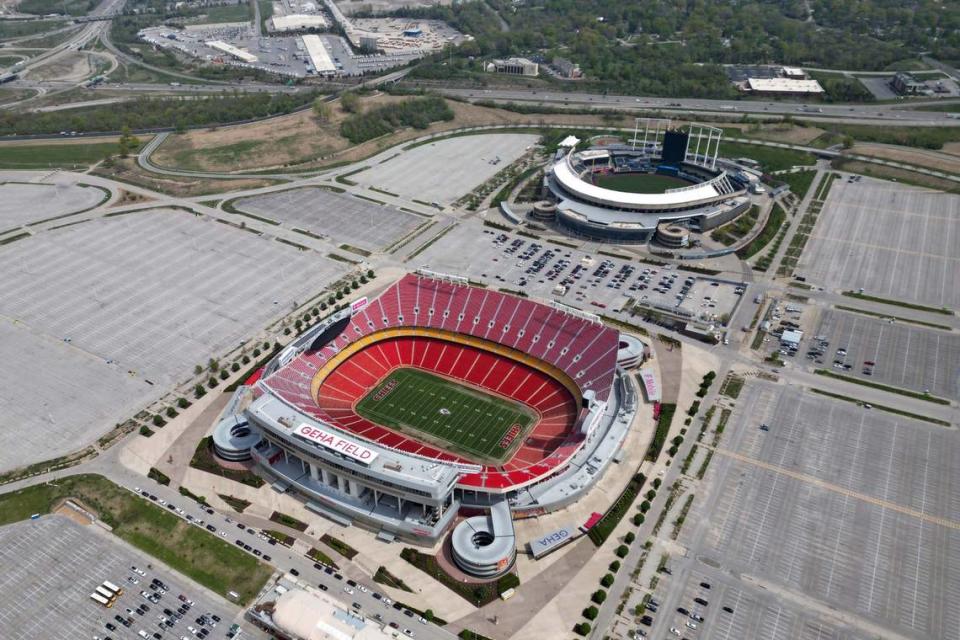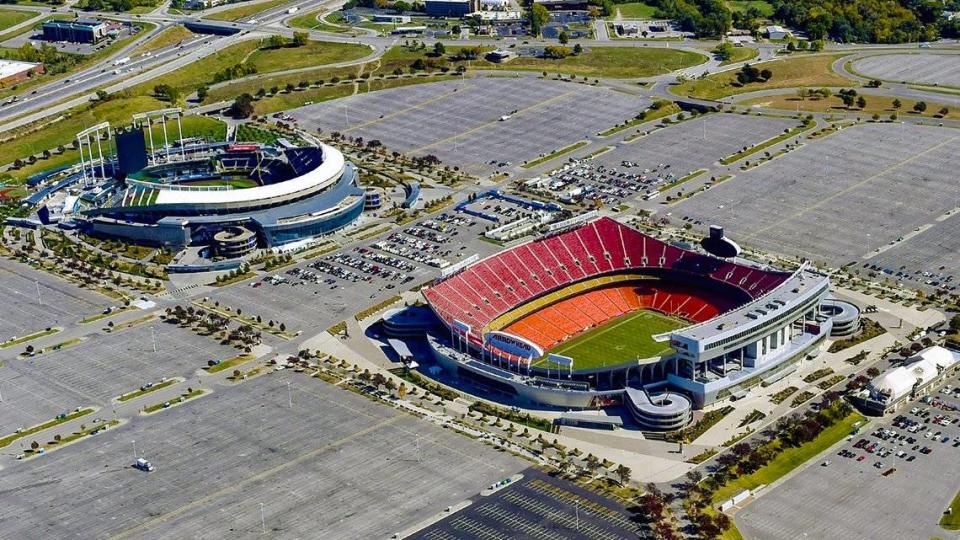Inside Chiefs’ plans for Arrowhead’s future as Royals drive Kansas City stadium debate
We’ve centered most of our professional stadium discussions on the Royals because, well, they started them. And by choice. But as they proceed with intentions to vacate the Truman Sports Complex, lurking around the corner is what they leave behind.
The Chiefs.
Oh, yeah, those guys. The reigning Super Bowl champions. A bit more than an afterthought.
Although they aren’t the driver of the public dialogue, they’re more than a passenger behind the scenes as they explore three options for their future residence: the renovation of GEHA Field at Arrowhead Stadium, a new venue replacing Arrowhead on the same site, or a new build elsewhere.
They’d prefer the renovation, they say, if everything falls into place.
If. Let’s come back to that, because there’s more at play than you might think.
What would a renovated Arrowhead Stadium look like? At what cost? How much of that burden would fall to taxpayers? Which taxpayers? And what about those other options?
I spoke with officials involved in the process to determine the teams’ future homes, and while the Royals and Chiefs have shared a Truman Sports Complex lease for more than 50 years, here’s what’s most clear:
They are not only planning a geographical split but an even more obvious separation philosophically. Their preferences for the next 50 years, or at least the next 25, center on fundamentally different projects.
As the Royals pursue the shiny new object surrounded by all the bells and whistles in downtown Kansas City or just outside its river perimeter, the Chiefs hope their project would keep the sentimentality of a stadium and the tradition that surrounds it.
The short of it: The Chiefs’ Plan A is a new-look Arrowhead Stadium but the preservation of the old-school environment.
If they settle on a renovation at their current complex, those blueprints do not include a roof to cover the stadium, sources told The Star. Instead, the Chiefs would aim to upgrade their stadium, particularly fan and VIP experiences inside the joint, while trying to preserve its 76,000 capacity. They have also identified improvements to their tailgating, parking and ingress and egress to and from the stadium. Those inside the organization are quick to point out the upkeep of a half-century-old stadium can grow expensive too.
While the Royals have their sights set on not only a $1 billion stadium but a privately funded $1 billion ballpark district encircling it, the Chiefs’ studies have not shown an appetite for multi-use entertainment at the Truman Sports Complex. They have analyzed the potential for a small amphitheater to host concerts, but a source poured cold water on the idea of hotels, restaurants or office space.
Sure, the Chiefs would love to scoop up cash on peripheral development, as the Royals stand to do in either of their proposed sites, but can we acknowledge the obvious? The real estate matters as much as anything else, and it’s the Royals, not the Chiefs, on a path to wind up in the most attractive location.
Think of that twist: the Chiefs, reigning Super Bowl champions, envious of something the Royals, possessing one of baseball’s worst records, might get.
Of course, this is all just if they’re able to follow through on Plan A.
If.
If.
If.
That word pops up often in talks with the major players, and it’s because the Royals have not yet made a decision on their stadium site. Even as the Chiefs portray progress on their plans, they’ve needed to create more contingency plans — some hinging on the Royals’ next move and some on the to-be-determined support they still need elsewhere.
The Royals are still flirting with two cities and two counties — and therefore two different tax bases — with options in downtown’s East Village and north of the river in Clay County. They say their decision will come by the end of September and that they’re eyeing a move ahead of the 2027 or 2028 season, which would require them to break the current lease that runs through 2031.
But whatever deal they strike to end the lease would need to be approved by the Chiefs — and, logically, therefore benefit the Chiefs. And even as the two sides have separately described the other as good working partners, their interests don’t always align. If the Royals leave and the Chiefs stay, for example, who pays for the demolition of Kauffman Stadium? Some have estimated that cost to be more than $35 million. No one has yet raised their hand.
They are working on similar timelines in terms of going to a public vote — the Chiefs insist they’d be ready to join the Royals on an April 2024 ballot in Jackson County to renew a 3/8th-cent sales tax — but toward much different endpoints. And in some cases, multiple endpoints.
“The reality is we gotta be prepared to be flexible,” Chiefs team president Mark Donovan said.
Flexible between two markedly different ideas.
The Chiefs aren’t simply exploring where to put a new stadium, but also whether they’ll have a new stadium at all.
Which, let’s step back and talk about that for a second. The Chiefs have never had more momentum in their organization’s history — that’s proven true on the business side, Donovan said last month during a news conference at training camp.
That makes it a bit, well, surprising, that they aren’t eager to use their momentum to capitalize on a moment that won’t come around for another 25 years. This isn’t an endorsement of maximum tax dollars for stadiums — I want to make that clear — but rather stating what should be obvious. This is strategically their best time to make the ask.
Instead, the Chiefs, led by the most popular athlete in the country’s most popular sport, are prioritizing a way to stay in their current home, while the Royals, barreling toward 100 losses once more, are seeking to build a new venue.
Even if taxpayers will be footing a portion of both bills — heck, even if it winds up being a similar total — that’s quite a snapshot.
But if your fandom prompts some sort of sentimentality for Arrowhead Stadium, it still doesn’t match the nostalgia felt by owner Clark Hunt, whose father once called the venue his favorite place on Earth. Don’t underestimate that factor.
Oh, and then there’s the price — both to the public and the Hunt family. Don’t underestimate that factor, either. A renovation at the current site might be completed for less than $1 billion, per sources. A new stadium, which would much more likely include a dome option, could run in the neighborhood of $2.8 billion. That’s a significant difference.
Who pays for either?
The Chiefs, and all involved, for that matter, are certainly aware of what a couple of their league counterparts have recently secured financially, and they are setting similar expectations, I’m told — though in terms of the percentage of public investment, not total dollars.
The Titans are slated to receive more than $1.2 billion in public funding for their new $2.1 billion stadium project, including $500 million from the state of Tennessee. That’s about 57% publicly funded, 43% privately funded.
And for an estimated $1.5 billion stadium, Buffalo will receive $850 million in public funds, which equates to a nearly identical percentage as the Titans.
That percentage is the thing to remember.
But here’s what’s also clear in this process: While the Chiefs currently have a bigger brand in Kansas City, that will not necessarily secure them a bigger bag than the Royals’. Do the math, and it’s apparent they will need more than local support to reach that same public support that the Bills and Titans did, even for a renovation.
The Jackson County tax, if indeed shared — and that’s far from a guarantee with Clay County still pushing hard for the Royals — would net each team about $300 million to $350 million.
In addition to meetings with county and city leadership, the Chiefs have met multiple times with Missouri Gov. Mike Parson about what they’re seeking.
Keep in mind, while the Royals stated plainly from the jump that they plan to stay in Missouri, in a bi-state metro area, the threat of moving to Kansas could prove a powerful motivator for satisfying the Chiefs. It’s still on their table.
It certainly didn’t appear accidental that, when discussing this topic at the onset of Chiefs training camp last month, Donovan provided a list of events that GEHA Field at Arrowhead Stadium has hosted or will soon host, aside from the Super Bowl-winning team — things like concerts and forthcoming World Cup matches.
About all he didn’t plainly say: This is what you’ll lose if we head west. And rather than losing it to, say, California, the loss will be visible across the state line with a pair of binoculars.
A self-described Chiefs fan, Parson considers keeping the team in Missouri a high priority, lawmakers told The Star.
But it won’t be solely up to the governor.
Some wonder, if not doubt, whether he could do enough to convince the legislature to spend hundreds of millions on any stadium, regardless of its occupant. One hurdle: a fraction of the state Senate wary of a government handout to billionaire team owners. Another: the powerful sphere of St. Louis lawmakers perceived to be more concerned about the Cardinals than any team on this side of the state.
The Chiefs aren’t inclined to be picky about where the money comes from, as much as they are with the sum, but they know it’s a difficult road to secure the bulk of that sum from the state — and that it would be an even greater challenge to secure enough for a new stadium.
If the Royals move north of the river, however, the Jackson County renewal tax could erase the Royals from the split and therefore produce double the funds for the Chiefs — as long as voters remain on board, of course.
The more conversations you have with people involved in these moves, the more you hear the theory that a Royals move to Clay County could aid the Chiefs— while others say it’s not the driving force in each team’s decision, it’s more than a footnote.
Royals majority owner John Sherman acknowledged last month that the Royals’ polling “becomes a little choppier” if the Chiefs are not attached to a potential ballot measure in Jackson County. But the inverse is not necessarily true — the Chiefs’ brand could be enough to carry a vote on its own, particularly if they seek to keep Arrowhead, likely a popular decision with fans. But that only comes into play, of course, if Royals leave Jackson County.
That’s all to say there are a lot of moving parts.
The Royals will be one of them.
But the Chiefs?

 money
money 

